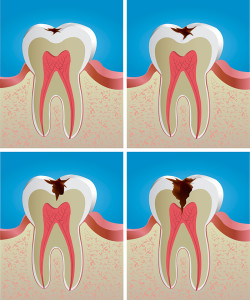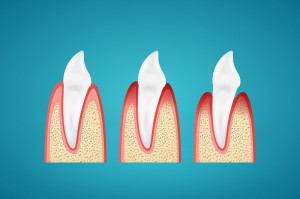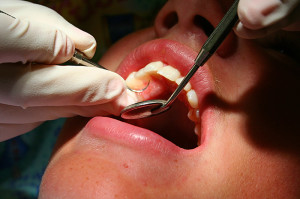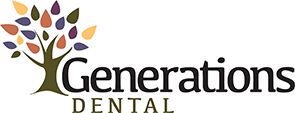Dental Caries / Decay
 Dental caries is the bacterial infection of the mouth which eventually leads to breakdown of teeth to form dental decay or cavities (holes) in your teeth. Cavities occur when risk factors for disease outweigh the protective factors for health. Dental caries is the number one disease (of all diseases) to affect children and is still the leading cause of tooth loss in all age groups. The bacteria in dental decay can be passed from one individual to another.
Dental caries is the bacterial infection of the mouth which eventually leads to breakdown of teeth to form dental decay or cavities (holes) in your teeth. Cavities occur when risk factors for disease outweigh the protective factors for health. Dental caries is the number one disease (of all diseases) to affect children and is still the leading cause of tooth loss in all age groups. The bacteria in dental decay can be passed from one individual to another.
Caries risk is rather complex but includes; the type and number of bad bacteria in your mouth at any given time, what and how often you feed them (and you), your body’s immune response to this infection, how well and often you remove the bacteria from all the tooth surfaces, your decay history, your genetic make-up, your saliva quantity and quality, salivary acidity, frequency of your dental visits, and appliances that make cleaning more difficult like braces and partial dentures.
Here at Generations Dental we evaluate for changing risk factors at every visit. We incorporate information from your history, habits, diet, and home care techniques. We also may do a special bacterial test to determine the numbers of bad bacteria in your mouth. Also we will access the amount of acidity in your mouth which fosters the growth of these bad bacteria.
Then it’s time for solutions. We sit down with you and review what risks are particular to you. Then look to see what modification might work in your life to restore a healthy balance for long term oral health. We may use specialty products like Carifree rinses and antibacterials. We may modify your diet and home care. We may use sealants or moistening agents.
Gum Disease
Periodontal (gum) disease is a bacterial infection of the supporting tissues (gums and bone) surrounding you teeth. Some studies show gum disease exists in as high as 75% of the adult population. Periodontal disease is usually slow and progressive, often taking years to go from its earliest stages to an advanced problem. It usually can cycle in and out of more active destructive periods. The problem is that gum disease rarely hurts until the later stages when it may be too late to fix. Gum disease is also a leading cause of tooth loss in its latter stages.
 Risk for periodontal disease is also complex and includes; the types and numbers of bad bacteria in and along you mouth and gums at any given time, your body’s immune response to this infection, your current gum disease status, your genetic make-up, how well and often you remove the bacteria and their byproducts from the “pocket” or “cuff” formed by your tooth and gum, your smoking status, having certain medical conditions such as diabetes or other inflammatory diseases, stress, and how frequently you see your dentist.
Risk for periodontal disease is also complex and includes; the types and numbers of bad bacteria in and along you mouth and gums at any given time, your body’s immune response to this infection, your current gum disease status, your genetic make-up, how well and often you remove the bacteria and their byproducts from the “pocket” or “cuff” formed by your tooth and gum, your smoking status, having certain medical conditions such as diabetes or other inflammatory diseases, stress, and how frequently you see your dentist.
We take gum disease very seriously, carefully checking for the clinical signs of disease at every visit. For those at higher risk we may employ specific bacterial testing, or even some genetic testing if applicable. This information might give us the edge we need in intercepting disease at its earliest stages.
In this day and age unfortunately dentistry does not have a cure for periodontal disease. The goal is usually to stop or slow the disease process. At generations Dental we will incorporate a custom plan based on the findings, your desires, and your budget. Our best defense is early identification and preventive cleanings in the earliest stages. More advanced cases may need more extensive or frequent visits to control the bacteria. Based on testing the use of antibiotics, antibacterial products and rinses can be used. Often an improved commitment to better homecare can make a huge difference in controlling the disease as well.
Occlusal Disease (Bite/ TMJ)
Occlusal disease is a collection of disorders involving the jaws, jaw joints (TMJ’s) jaw muscles, and biting surfaces of the teeth. It includes the act of normal chewing as well as the acts of clenching and grinding, and how these forces may affect the long term health of the whole oral system. Also included are the roles of attrition (functional wear), abrasion (tooth bushing wear), erosion (acidic loss of tooth) and abfraction (compressive stress defects) all of which lead to loss of tooth material and lead to sensitivity of teeth.
More on Bite/TMJ
Risks for occlusal disease are many. Heavy clenching and grinding can have long term effects on the health of jaw joints, muscle tenderness, tooth wear and accelerating gum disease. Physical wear of the teeth through mechanical (tooth brushing, grinding) can be accelerated by chemical (acidic) softening of the enamel. Acids can be introduced orally by high levels in the diet, or from internal stomach acids during gastric reflux, anorexia, or bulimia. A high correlation exists between those who either grind their teeth, have gastric reflux (GERD), and have sleep apnea for risk of the other two. All of which can have slow progressive destruction of tooth structure over time.
We are uniquely in tune with all of these factors at Generations Dental. Preserving your teeth from risk of any source and having a healthy jaw system is exceptionally important. Use of the Carifree products will aid in neutralizing the acidic environment and strengthening the teeth. Your bites can be analyzed and may be modified for better function and relief of stress. The use of custom mouth guards can be used to relieve stress to muscles and jaw joints.
Oral Cancer
While some think that oral cancer is rare, mouth cancer will be newly diagnosed in about 100 new individuals each day in the US alone, and a new person dies from oral cancer every hour of every day.
Oral cancers are usually found in late stages, but when found early have a 80-90% survival rate. Help us help you catch things early. Honest, accurate reporting of potential risk factors can be critical.
Risks for oral cancers include; use of smoke or smokeless tobacco products, consumption of alcohol especially greater than one beverage per day, testing positive for human papilloma virus (HPV) has increased risk for cancers of body linings including the oral cavity, and diet low in fruits and vegetables is also being implicated as a factor.
 We provide a thorough head, neck, and tissue exam for oral cancer at every visit. We encourage you to report any sores, lumps or suspicious area that persists longer than 3 weeks, between your dental visits. Most abrasions, food burns, viruses, canker sores etc. will usually self-heal in shorter time spans. We also have at our disposal a salivary test for HPV status detection. We are always evaluating other screening devices for better early detection.
We provide a thorough head, neck, and tissue exam for oral cancer at every visit. We encourage you to report any sores, lumps or suspicious area that persists longer than 3 weeks, between your dental visits. Most abrasions, food burns, viruses, canker sores etc. will usually self-heal in shorter time spans. We also have at our disposal a salivary test for HPV status detection. We are always evaluating other screening devices for better early detection.
Reduction of risk factors is always encouraged as part of the health plan. Once a suspect area is discovered a sample of tissue (biopsy) may be needed for evaluation. A custom plan of treatment would then be followed.
